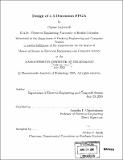Design of a 3-dimension FPGA
Author(s)
Lajevardi, Payam
DownloadFull printable version (5.198Mb)
Alternative title
Design of a 3D Field Programmable Gate Array
Other Contributors
Massachusetts Institute of Technology. Dept. of Electrical Engineering and Computer Science.
Advisor
Anantha P. Chandrakasan.
Terms of use
Metadata
Show full item recordAbstract
The intercornnect delay in the new generations of integrated circuits imposes a significant limitation on the performance of ICs. 3-Dimensional integration of integrated circuits had been proposed to improve the interconnect delay. In this research, the effect of 3-D integration on the delay and power of FPGA chips is analyzed. Different physical partitioning of FPGAs is proposed for 3-D integration and one is analyzed in detail. The size of 3-D FPGAs differs from the size of 2-D FPGAs because of the overhead of 3-1D connections and different connectivity in switch blocks. Layout of 2-D and 3-D FPGAs is prepared to compare their size. To compare 3-D and 2-D FPGAs properly, two basic routability metrics are proposed to compare the routability of 3-D and 2-D circuits. Then, the delay of a 2-D and a 3-D FPGA with the same routability is compared. It is shown that 20%-29% delay improvement can be achieved by using a 3-D FPGA. In addition, the power consumption of 3-D FPGAs is analyzed. It is shown that if the supply voltage and the operating frequency of a 3-D FPGA are held to be the same as a 2-D FPGA, 17%-22% power improvement can be achieved. However, 3-D FPGAs can run faster since their delay is improved as well. If the delay improvement is traded off for more power saving by lowering the supply voltage, 35%-39% power improvement can be expected. Finally, to reduce the magnitude of supply current required for an integrated circuit, the method of stacking logic circuits is analyzed. This method requires level conversion between different supply domains. In this research, the architecture of several level converters are described and their delays are compared.
Description
Thesis (S.M.)--Massachusetts Institute of Technology, Dept. of Electrical Engineering and Computer Science, 2005. Includes bibliographical references (p. 67-71).
Date issued
2005Department
Massachusetts Institute of Technology. Department of Electrical Engineering and Computer SciencePublisher
Massachusetts Institute of Technology
Keywords
Electrical Engineering and Computer Science.